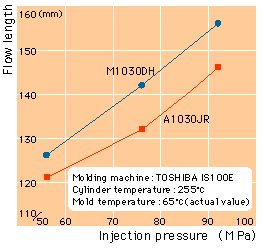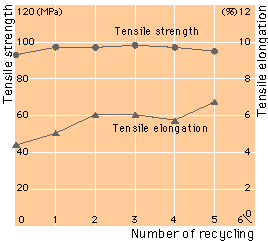Nano-Composite Nylon6
Moldability
Standard Molding Condition
|
|
|
|
|
|
|
|
nylon 6 |
nylon 6 |
-reinforced nylon |
|
|
temperature (°C) |
|
|
|
|
|
|
|
|
|
|
|
|
|
|
|
|
|
|
|
|
|
|
|
pressure (MPa) |
|
|
|
|
|
|
|
|
|
|
|
|
|
|
|
|
|
|
|
|
|
|
|
|
|
|
|
|
Example of Molding Condition
| |
|
|
||
| |
|
|
||
| |
|
|
||
| |
P165/75 |
IS100E |
||
| temperature (°C) |
|
|
|
|
| |
|
|
||
| |
|
|
||
| |
|
|
||
|
|
|
|
||
| pressure (MPa) |
|
|
|
|
| |
|
|
||
| |
|
|
||
| |
|
|
||
| |
|
|
||
| |
|
|
||
-
Flowability
The flowability of M1030DH and A1030JR resins during bar-flow molding (thickness: 1mm) is shown in Figure 9. The flowability of M1030DH is larger than that of A1030JR.
Figure 9. Flowability
(Bar flow, thickness: 1 mm)
-
Recycling Property
The change in tensile properties of the resins after 100% recycling is shown in Figure 10 (resin temperature: 250°C). The nanocomposite resin does not exhibit any decrease in strength even after 5 repeated complete recycling, but allows slight increase in elongation.
Figure 10. Recycling property
(100% recycling)
Molding Shrinkage
In Figures 11 and 12, shown are the molding shrinkages of resins, as determined by using a rectangular molded plate with a film gate of 50x50 mm in dimension. The molding shrinkage of the plates from the M1030DH resin is similar to that of a general nylon 6 A1030JR, but the nanocomposite plates have some anisotropy. In addition, the effect of the mold temperature on the molding shrinkage of M1030DH is characteristically smaller than on that of A1030JR.
| Figure 11. Molding shrinkage (thickness:1mm) | Figure 12. Molding shrinkage (thickness:3mm) |


